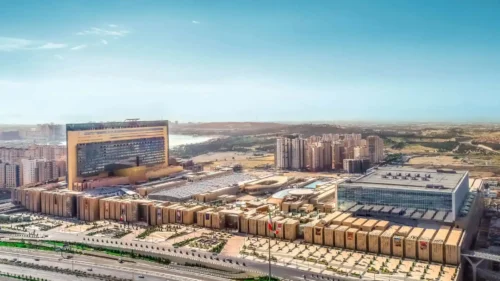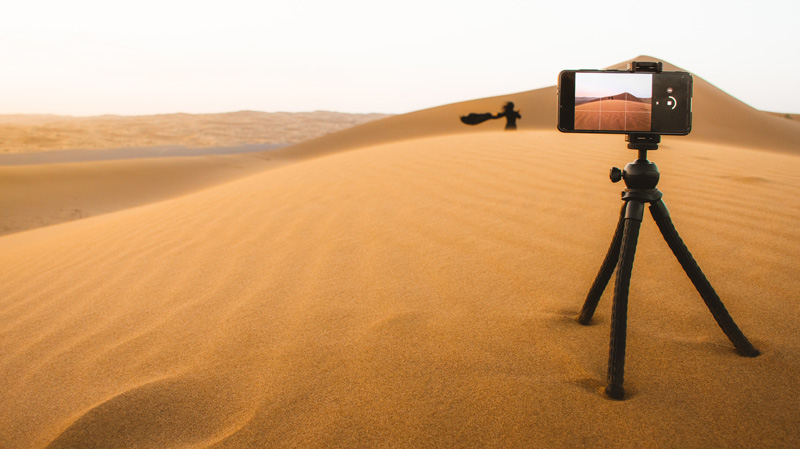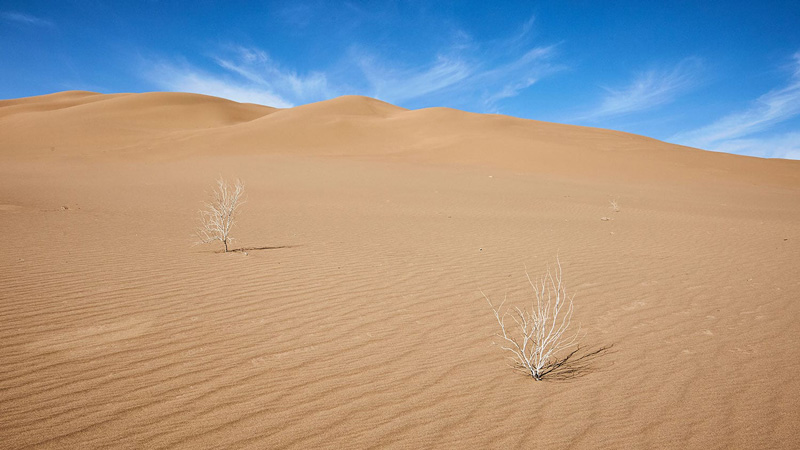
وبلاگ سپهران | Attractions | Rig-e Jenn Desert (Iran’s Bermuda Triangle)
Rig-e Jenn Desert (Iran’s Bermuda Triangle) , A mysterious journey to Iran’s enigmatic desert.
With an area spanning approximately 3,800 square kilometers, Rig-e Jenn is one of Iran’s most pristine and valuable desert regions. Its unique geological features, including its vast expanse and lack of springs or water wells, kept it unexplored by humans until recently when a few well-equipped desert expeditions ventured into it. No human had set foot there, and there were no signs of life reported until just a few years ago.
In most maps, you won’t find any reference to this area; only two European desert explorers had mentioned such a desert in Iran in their travelogues.
Iran’s Bermuda Triangle lies within the expansive desert of Iran, one of the hottest and driest regions on Earth. This desert, resulting from the erosion of the Central Iranian Plateau, is characterized by its sand dunes and salt flats. There are no precise borders for this desert region, but in general terms, Rig-e Jenn extends from the north to southern Semnan and southeastern Garmsar, from the west to the Rig-e Jenn Desert National Park and the Tang-e Zolemat, from the east to the Jandaq and from the south to northern Anarak and Chupanan.
The Rig-e Jenn Desert, the location of Iran’s Bermuda Triangle, is situated in the southeastern part of Iran. This desert is one of the largest salt deserts in the world, covering an area of approximately 51,800 square kilometers. It is known for its vast salt flats, sand dunes, and rocky plateaus.
The average elevation of the Rig-e Jenn varies between 680 to 7,207 meters, excluding the sand dunes. Therefore, the lowest sand dunes are found in the northern part of the Rig-e Jenn, while the highest elevations are in the western region.So, the decrease in elevation in the northern areas and the presence of underground water sources have led to the formation of wet, marshy deserts and salt flats in this region.
The climate in this area is influenced by the Central Iranian Plateau and is characterized as dry and desert-like. The rate of evaporation exceeds rainfall, resulting in extremely hot and dry summers, and seasonal weather fluctuations, including intense sunshine. Temperature differences between the northern and southern parts of the Rig-e Jenn are not significant, with temperatures ranging between 48+ to 50+ degrees Celsius in July. The maximum humidity, around 71%, occurs in December, while the minimum, around 22%, is observed in June.
The northern and central parts of the Rig-e Jenn, especially the marshy and plain areas, are almost devoid of any vegetation. However, in the outer fringes of the steppes and near the Nakhjir and Siahkouh Mountains in the northwestern and western regions of the area, some plant species can be found, albeit in limited numbers. These plant species include halophytes, Salsola, Astragalus, kharshotor, wild barley, barije, mountain mint, wild lettuce, Scanbil, echinops and ghech.
The distribution of wildlife in this area is also primarily concentrated in the peripheral regions due to the presence of plant cover. Reports have mentioned the presence of Persian gazelle and the Iranian sand cat in the vicinity of Sinekuh, Gorg-e Gorg, Tang-e Zalmatat, and the foothills of Kafrekouh. In the Dam Rig region, due to increased plant cover, species such as sand fox, sand cat, caracal, hare, gerbil, and Pallas’s cat have been observed. Various snake and scorpion species, jackals, shahins, desert spiny-tailed lizard, golden eagle, wolves, and foxes have also been spotted in this area.
The Semnan Desert, also known as Rig-e Jenn, is bounded by the Nakhjir Mountains and the Rig-e Jenn National Park to the west, the Jandaq County to the east, the Garmsar and Semnan Counties to the north, and the Anarak-Mollahadi transportation route to the south.
To reach the Rig-e Jenn, you have several options: You can enter this desert from the south of Semnan, southeast of Garmsar, or west of Anarak.
The most important aspect of traveling to the Rig-e Jenn is to be accompanied by an experienced guide who is knowledgeable about navigation, stargazing, and equipped with the necessary gear to ensure that this experience becomes unforgettable and doesn’t turn into a crisis.

Traveling to the Rig-e Jenn is possible, but it requires knowledge, equipment, and physical and mental readiness. The first thing to consider is the weather conditions. Spring is a suitable time for a trip to this area. You should avoid days with storms and strong winds when planning your trip to the Rig-e Jenn.
In general, the fall and winter seasons can be considered the best time for a journey to the Rig-e Jenn. It is recommended to travel with a local guide and the necessary equipment. Additionally, it is mandatory to inform local authorities before your trip.
The Rig-e Jenn has countless beauties, from its sandy dunes to the starry night sky. However, before choosing your travel time, be sure to check the weather conditions. Make sure that during your trip, the sky is clear of clouds and filled with stars, as sometimes the weather in this region can become cloudy and obscure the beauty of the night sky.
Note: Please note that this list is based on information available as of 2022 and is subject to change. To ensure the accuracy of the information, contact local authorities before your trip.

The Iranian Bermuda Triangle, located in the vast expanse of the Rig-e Jenn, is one of the hottest and driest places on Earth.
In 1900, the Swedish desert explorer and geographer Sven Hedin attempted to be the first human to set foot on the Rig-e Jenn, although he did not succeed. Nevertheless, he passed through its western and southern peripheries and wrote extensively about it in his book “The Deserts of Iran.” Thirty years later, inspired by Hedin’s book, the Frenchman Gabriel set out on a journey to this region with the aim of crossing it. However, like Hedin, he could only manage to cross the Rig-e Jenn’s latitude and published his experiences in a book titled “Crossing the Iranian Deserts.”
Crossing the Rig-e Jenn remained impossible until 2001 when Ali Parsa, an Iranian desert explorer, finally succeeded after eight unsuccessful attempts with camels to cross the Rig-e Jenn completely.
Various unusual phenomena have been reported from the Iranian Bermuda Triangle. Some of the most common reports include:
The remoteness of this area has always been very mysterious to the local inhabitants. The local people considered the Rig-e Jenn Desert a cursed land, a base for demons and evil spirits, and believed that anyone who set foot in the Rig-e Jenn would be swallowed and never return.
Despite the use of the word “Rig” (desert) in referring to this area, which evokes images of shifting sands, most of the Rig-e Jenn is covered by salt flats and flat, pebbly desert plains. Vast expanses of active sand dunes, devoid of vegetation, dominate the landscape.
The salt deposits and eroded materials in the region are similar to other areas in the central deserts of Iran. They are primarily formed from eroded materials of the Alborz mountain range, carried by the flow of rivers that reach the area. Due to the lack of vegetation cover, the desert floor is constantly changing and shifting under the influence of the wind.

While there is no shortage of paranormal theories surrounding the Iranian Bermuda Triangle, several scientific explanations have also been proposed. Some researchers believe that the high temperatures in the Rig-e Jenn Desert could influence the magnetic field of this region, causing disruptions in the functioning of compasses and electronic devices. Others suggest that the high salt content in the ground could interfere with the electrical systems of vehicles and electronic devices. However, at present, there is no consensus within the scientific community, and further research is needed to fully understand the phenomena occurring in the region.
The Iranian Bermuda Triangle has often been compared to the infamous Bermuda Triangle—a region in the Atlantic Ocean where numerous ships and airplanes have mysteriously disappeared. While there are certainly similarities between these two areas, several notable differences are observed. For instance, the Bermuda Triangle is known for the disappearance of ships and airplanes, whereas the Iranian Bermuda Triangle is more famous for mechanical failures and electronic malfunctions. Furthermore, the Bermuda Triangle is located along a heavily traveled route for ships, whereas the Iranian Bermuda Triangle is situated in a remote and sparsely populated area within the Iranian desert.
The Iranian Bermuda Triangle has had a significant impact on the lives of local communities residing in the surrounding areas. This region has become a popular destination for tourists and adventure seekers looking to experience mysterious phenomena. With the increase in travel to the area, it has brought economic benefits to the local communities. However, the influx of tourists has raised concerns about safety and environmental effects.
Local authorities have implemented safety measures and guidelines for travelers visiting the region, and efforts are underway to minimize the environmental impact of tourism.
If you intend to visit the Iranian Bermuda Triangle, it’s essential to observe safety precautions. Here are some safety tips for a secure journey:

Traveling to the Rig-e Jenn Desert can be a unique and thrilling experience that requires careful planning and adequate preparation. Carrying enough food and water, using a suitable vehicle, and having a local guide can ensure a successful and safe journey. You can share your comments, questions, and experiences about this extraordinary destination in the comments section.
Your experiences of traveling to the Rig-e Jenn Desert can serve as guidance for individuals planning to visit this desert. We recommend staying informed about the latest local information and conditions before your trip to ensure a safe and enjoyable experience. Safe travels!